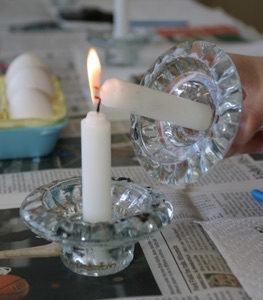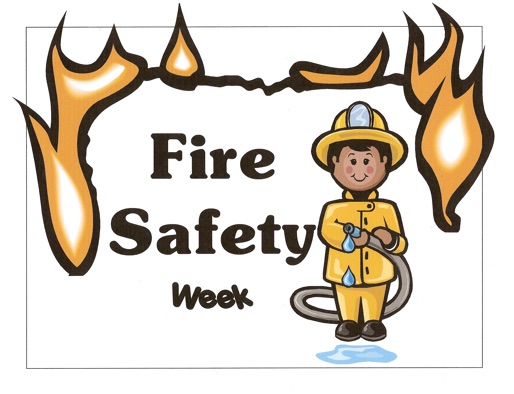Candle Safety


Candles are an invaluable part of pysankarstvo, used both for heating the stylus and melting the wax within it, as well as removing the wax from a finished pysanka. A lit candle is beautiful to behold, with its flickering primal flame.
But care must be taken when burning candles. The National Fire Protection Association report that candles are the 4th leading cause of house fires. During 2005, an estimated 15,600 home structure fires started by candles were reported to local fire departments in the USA. These fires resulted in an estimated 150 civilian deaths, 1,270 civilian injuries and an estimated direct property loss of $539 million. Almost 10% of civilian injuries and 6 % of civilian fatalities are due to candles
Mind you, many of these were started by unattended “decorative” candles, but it still pays to be careful. According to fire experts, the bulk of candle-fire incidents are due to inattention to basic fire safety or to the misuse of candles.
Other Hazards
A candle flame that is longer than its laminar smoke point will emit soot. Soot inhalation has known health hazards. Proper wick trimming will prevent soot emissions from most candles.
The liquid wax is hot and can cause skin burns, but the amount and temperature are generally rather limited and the burns are seldom serious. The best way to avoid getting burned from splashed wax is to use a candle snuffer instead of blowing on the flame. A candle snuffer is usually a small metal cup on the end of a long handle. When placed over the flame the oxygen supply is cut off. They were used daily when the candle was the main source of lighting a home, before electric lights were available.
Glass candle holders are sometimes cracked by thermal shock from the candle flame, particularly when the candle burns down to the end.
A former worry regarding the safety of candles was that a lead core was used in the wicks to keep them upright in container candles. Without a stiff core, the wicks of a container candle could sag and drown in the deep wax pool. Concerns rose that the lead in these wicks would vaporize during the burning process, releasing lead vapors — a known health and developmental hazard. Lead core wicks have not been common since the 1970s, although imported candles may still be found to have some lead core wicks (e.g. Chinese). Today, most metal-cored wicks use zinc or a zinc alloy, which has become the industry standard. Wicks made from specially treated paper and cotton are also available.
Safety Tips
Some safety tips (to help keep you from becoming another fire statistic) from the National Candle Association:
 Always keep a burning candle within sight. Extinguish all candles when leaving a room or before going to sleep.
Always keep a burning candle within sight. Extinguish all candles when leaving a room or before going to sleep. Never burn a candle on or near anything that can catch fire. Keep burning candles away from furniture, drapes, bedding, carpets, books, paper, flammable decorations, etc.
Never burn a candle on or near anything that can catch fire. Keep burning candles away from furniture, drapes, bedding, carpets, books, paper, flammable decorations, etc. Keep candles out of the reach of children and pets. Do not place lighted candles where they can be knocked over by children, pets or anyone else.
Keep candles out of the reach of children and pets. Do not place lighted candles where they can be knocked over by children, pets or anyone else. Trim candlewicks to ¼ inch each time before burning. Long or crooked wicks cause uneven burning and dripping.
Trim candlewicks to ¼ inch each time before burning. Long or crooked wicks cause uneven burning and dripping. Always use a candleholder. The holder should be heat resistant, sturdy and large enough to contain any drips or melted wax. (See photo above left)
Always use a candleholder. The holder should be heat resistant, sturdy and large enough to contain any drips or melted wax. (See photo above left) Keep the wax pool free of wick trimmings, matches and debris at all times.
Keep the wax pool free of wick trimmings, matches and debris at all times. Keep burning candles away from drafts, vents, ceiling fans and air currents. This will help prevent rapid, uneven burning, and avoid flame flare-ups and sooting. Drafts can also blow lightweight curtains or papers into the flame where they could catch fire.
Keep burning candles away from drafts, vents, ceiling fans and air currents. This will help prevent rapid, uneven burning, and avoid flame flare-ups and sooting. Drafts can also blow lightweight curtains or papers into the flame where they could catch fire. Don't burn a candle all the way down. Extinguish the flame if it comes too close to the holder or container.
Don't burn a candle all the way down. Extinguish the flame if it comes too close to the holder or container.  Never touch a burning candle or move a votive or container candle when the wax is liquid. DO NOT move a lit candle toward an unlit one to light it; keep the lit (left) candle still, and tip the unlit one (right) towards it. Otherwise, the hot wax can spill, cause burns, and catch fire.
Never touch a burning candle or move a votive or container candle when the wax is liquid. DO NOT move a lit candle toward an unlit one to light it; keep the lit (left) candle still, and tip the unlit one (right) towards it. Otherwise, the hot wax can spill, cause burns, and catch fire.

 Never extinguish candles with water. The water can cause the hot wax to splatter.
Never extinguish candles with water. The water can cause the hot wax to splatter. Extinguish a candle if it smokes, flickers repeatedly, if it sputters wildly or the flame becomes too high. The candle isn't burning properly and the flame isn't controlled. Let the candle cool, trim the wick, then check for drafts before re-lighting. If it continues to misbehave, toss it out (or, better yet, recycle it as a fire-starter).
Extinguish a candle if it smokes, flickers repeatedly, if it sputters wildly or the flame becomes too high. The candle isn't burning properly and the flame isn't controlled. Let the candle cool, trim the wick, then check for drafts before re-lighting. If it continues to misbehave, toss it out (or, better yet, recycle it as a fire-starter). Make sure a candle is completely extinguished and the wick ember is no longer glowing before leaving the room.
Make sure a candle is completely extinguished and the wick ember is no longer glowing before leaving the room.
Always be careful around candles; although they are necessary, they can also be quite dangerous.
Back to Main Candles page
Back to MAIN Pysanka home page.
Back to Pysanka Index.
Search my site with Google
Candle Hazards



